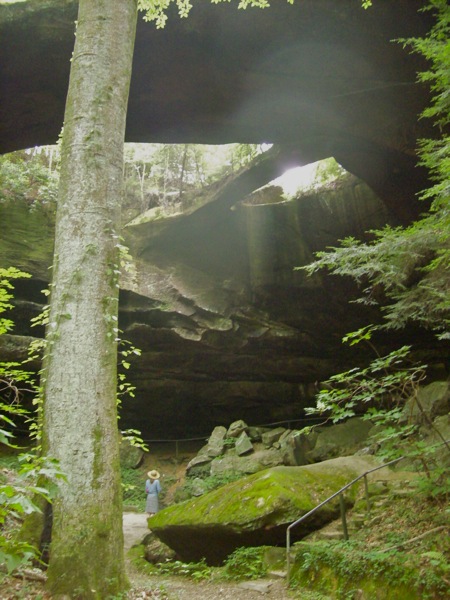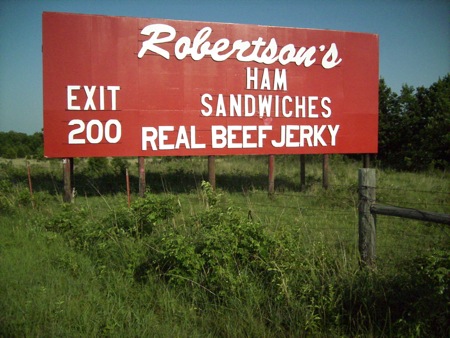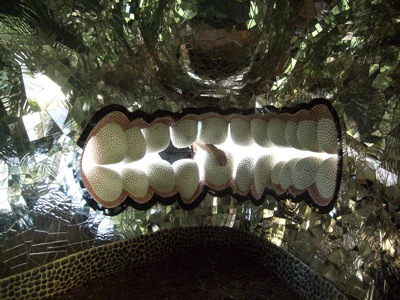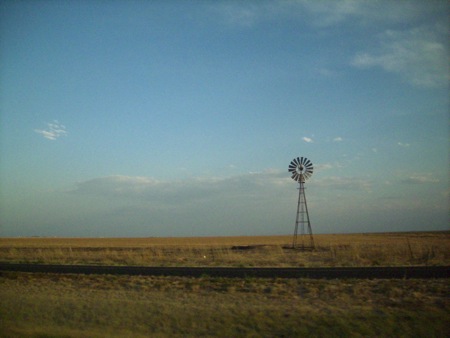“La Cabeza” is part of the show “Creation of a New Mythology,” now at the Bechtler Museum of Modern Art in Charlotte, N.C. Five monumental sculptures are outdoors in a public park across the street from the museum; and you can climb inside this sculpture. You can also stick your arm through its teeth.
Category: Road trips
At Amelie’s
Carol and I are sitting at Amelie’s, a French bakery in Charlotte, N.C., that’s open 24 hours a day, seven days a week. It’s after eleven o’clock on a Thursday evening, and there are lots of people here. At a table to my right, I can sort of hear two men talking about the theater. There’s a card game going on at aother table. There’s a couple who look to me as though they’re on a date. Two women sitting on couches are talking very seriously in low voices. That’s this room. There are two other rooms, the main bakery counter, and the outside patio. I’ve heard at least two languages other than English (Russian was one, and I’m not sure about the other). I’m seeing a lot of white folks, but there’s definite racial diversity here. And I’d guess that all of the people here are younger than Carol and me (that is, at least under 45). There is excellent wifi access, and I can see people checking Facebook and surfing the Web. We are sitting at a table with two laptops, a pear tart, a peach tart, and a cup of really good coffee:

OK. You know what the setting is like. Now, a lot of what I’ve been hearing about recently is how the shape of religion and spirituality is changing, and it’s increasingly taking place outside of traditional places of worship, particularly for people younger than me. If I lived in Charlotte, given that I’m something of a night owl, I have a feeling that I’d be spending a lot of time here. And if I were going to imagine a place where I’d want to do spirituality, this would be it. This pear tart can only be described as spiritual. Good wifi access, pleasant surroundings, interesting conversations going on around you — what more do you need?
If I had my way, church would look more like Amelie’s, and I’d be able to get fast wifi access and really good pear tarts and really good coffee there.
Hey, a guy can dream.
Ministry Daze, er, Days
Charlotte, N.C.
General Assembly hasn’t begun, but ministers and religious educators have already arrived here for professional meetings: “Ministry Days” for ministers and seminarians, and “Professional Day” for religious educators. I won’t say that the streets around the convention center are swarming yet with Unitarian Universalists, but when I went out to get lunch today I ran into Rosie and Marie, old friends from seminary, on the sidewalk, and Nancy, a minister from the Bay Area, while crossing the street, and I saw several other people at a distance whom I felt sure I knew.
Just after four o’clock, I went over to the Hilton Hotel to register for Ministry Days. There were ministers everywhere: ministers in sandals, ministers in seersucker suits, ministers in dresses, ministers in hip black West coast urban garb, ministers in Midwestern pastels, old ministers, young ministers, ministers all over the place. Some of them were people I have never seen before, some of them were people who looked familiar, some of them were people I once knew, a few were people I know quite well. Unfortunately, my brain does not allocate much processing power to my facial recognition software, so when I am in large groups of people I often cannot cannot process faces rapidly enough; as a result, I tend to wander around looking vaguely dazed and slightly bewildered (more so than usual, that is).
Fortunately, I ran into my old friend Ellen, with whom I served at First Parish in Lexington, Massachusetts under Hellen Lutton Cohen. Ellen had not yet eaten, and was looking a little pale, so we went right out and looked for a place to eat. All the cheap restaurants I had looked up on the Web seemed to close at five o’clock. We finally wound up in Halcyon, the restaurant next to the Mint Museum. Ellen told me all about the things they’re doing in her church in Chelmsford, Massachusetts — the successful evening worship service, the way she mobilizes amateur musicians within her congregation, their coming of age program, their youth service trips to Saint Bernard Parish south of New Orleans. Then it turned out that our waitress grew up on Nantucket, so she and I tried to figure out if we had any common acquaintances, but the people I know who live there are all quite a bit older than she. Then Carol joined Ellen and me, and we began talking about families. We walked Ellen back to her hotel, talking all the while.
By the time we got done, today’s program for Ministry Days was over. Yet though I hadn’t attended any official programming, I got more good ideas while eating dinner with Ellen than I get in most half-day professional workshops.
Small “u” universalists are everywhere
Today I attended the annual Macedonia Church Singing, a group of people who have been singing shape note hymns on Sand Mountain in Alabama for generations. This is one of the few parts of the country where churches sing in four part a capella harmony from the The Sacred Harp, a four-shape note hymnal, in regular Sunday services. Thus, liturgically speaking it is one of the more conservative parts of the United States; they still conserve some of the old ways of conducting Sunday services that date back a hundred and fifty years or more.
At lunch I sat down across from a fellow who was also singing in the bass section, and when he found out that I was a Unitarian Universalist he grinned and said, “I’m a Christian universalist.” We spent the rest of the lunch hour talking about James Relly — when he found out I hadn’t actually read Relly, he said I simply had to do so — and about Rob Bell, and the Primitive Baptist Universalists, and Hosea Ballou. He probably knew more about universalism than I did, although I was able to tell him one thing that he didn’t know: that Abraham Maxim, one of the composers in The Sacred Harp, had been a Universalist.
It turns out that he belongs to a Methodist church, where he is a Bible study leader. When he became convinced of the truth of universalism, he offered to step down as a study leader, but his church thought it would be fine if he stayed on. I asked about his pastor, and he said that his pastor seemed to have universalist leanings, though of course he didn’t come right out and say so, he just never preached about hell.
You just never know when you’re going to run into another universalist.
Mississippi Central, Holly Springs, Miss.

A Mississippi Central locomotive in the small rail yard next to the old Holly Springs, Miss., depot building. Mississippi Central is a short line railroad now owned by a railroad holding company.
Photo from yesterday’s travels; I’m putting it here because James said he expected more trains.
Natural Bridge, Alabama

The 148 foot long natural bridge that gives the town of Natural Bridge, Alabama (pop. 28) its name. To get a sense of scale, note that Carol is standing in the foreground looking up.
Memphis: Civil Rights Museum
Carol and I went over to the Civil Rights Museum this afternoon. The museum has been constructed on the site of the Lorraine Motel, where Rev. Dr. Martin Luther King, Jr., was shot and killed on 4 April 1968. The exhibits are well-done and exhaustive, and very heavy on text — it took me two hours to read through the exhibit material, skipping over about half of the reproduction documents and explanatory text, and I only got halfway through the museum. You read about the big events — the sit-ins, the Freedom Riders, the Highland Folk School, and so on — but you also get to read about some of the smaller cities where things happened, and the one-person sit-ins that took place. For me, though, the most powerful moment in the museum was towards the end of the documentary film that served as an introduction to the museum, when Rev. Billy Kyles tells the filmmaker that King got shot because he was beginning to talk about economic inequality; in Kyles’s opinion, when King spoke out about economic inequality, that was more dangerous than speaking out about racial injustice. Given the increasing economic inequality in the United States today, that really struck home for me.
We headed out of the dark air-conditioned museum into the heat of a bright, sunny Memphis afternoon. Carol wandered over to where a woman sat behind a booth under an umbrella. On the front of the booth was a sign that read “Gentrification is an abuse of Civil Liberties.” We got to talking with the woman, whose name was Jacqueline Smith. She was the last person to live in the Lorraine Motel — apparently it housed quite a few permanent residents in the 1980s. The state of Tennessee forcibly evicted her in January, 1988, so they could take over the Lorraine Motel and turn it into the Civil Rights Museum. She said she believes that a more fitting monument to King would have been to turn the Lorraine Motel into housing for the poor, or some other project that furthered King’s ideals. She also pointed out how the neighborhood was being gentrified. “There’s an American Apparel store now, over in the next block,” she said scornfully. “Where are the poor people supposed to live?” She has a point. Chain stores like American Apparel usually mean the death of small locally owned businesses. In an article in today’s New York Times business section titled “A Slowdown for Small Businesses,” reported Catherine Rampell points out that small businesses are not doing well these days:
While big companies are buoyed by record profits, many small businesses, which employ half the country’s private sector workers, are still struggling to break even. And if the nation’s small businesses plan to further delay hiring — or, worse, return to laying off workers, as they now hint they might — there is little hope that the nation’s 14 million idle workers will find gainful employment soon. [p. B1]
Jacqueline Smith pointed out that the Civil Rights Museum was sponsored by many large businesses. I had already noticed that — half of one memorial mounted below Room 306 in the Lorraine Motel, the room where King had been staying before he had been shot, was devoted to extolling the virtues of its big corporate sponsor. That struck me as crass commercialism, at best; or disrespectful, at worst; take your pick.
Carol asked if we could take Jacqueline Smith’s photo and post it here, and she said we could. Ms. Smith also gave us a poster showing Dr. King, with the words “I tried to be right, I did try to feed the hungry, I did try to clothe the naked, I tried to love and serve humanity,” and in the photo below she is holding this poster. You can see the balcony where King was shot just above her in the photo.
Photo by Carol Steinfeld.
Ms. Smith has her own Web site where she promotes her point of view. She says in part: “Sadly, [the Civil Rights Museum] fails to live up to [its] ideals. The truth is that the museum has become a Disney-style tourist attraction, which seems preoccupied with gaining financial success, rather than focussing on the real issues.” And this raises the very interesting question for me: has Martin Luther King’s legacy become too sanitized?
Memphis
We arrived in Memphis in the middle of the afternoon. We are here to act like tourists. The Center for Southern Folklore was closed, so we walked along the bank of the Mississippi River, and saw the cobblestone landing where river boats have been landing for the past 150 years. Carol found W. C. Handy’s small little shotgun house — W. C. Handy! I couldn’t believe it! — and she took a picture of me sitting stiffly on the front porch. We ate dinner at B.B. King’s Restaurant, hoping to hear Blind Mississippi Morris, but he was feeling under the weather and when two young men started playing Eric Clapton, we left. We took photographs of the Purple Martin houses on Memphis rooftops, and I watched the the Common Nighthawks swooping overhead calling, “peent, peent.” We talked to a guitarist in Central Station, the old railroad station still used by Amtrak; he was waiting for the City of New Orleans, and playing his guitar in that huge cavernous space while he waited. And after the sun went down, we walked down Beale Street at night, listened to the blues pouring out of the windows of the clubs, and watched the people walking up and down the street.
It was a satisfyingly touristy day.
I-40, near Seminole, Oklahoma

Gallup to Amarillo
We left Gallup in the morning, and not too far eastward everything began to look hazy. Then it was more than hazy: everything began to look foggy. We noticed that some drivers coming the other direction had their headlights on. Then I began to smell smoke very faintly. “This must be the smoke from the wildfires in Arizona,” I said to Carol.
When we got to the BLM ranger station at El Malpais National Conservation Area, there was a note under the day’s weather forecast about the smoke from the wildfires. From the trail behind the ranger station, we could see how a range of mountains to the north of us was mostly obscured by the smoke:
We stopped for a late lunch in Albuquerque. I couldn’t remember the name of the restaurant Dad had recommended, so we went to Old Town. Although it was very tourist-y, we agreed that we were tourists, so it seemed just about right. The owner of Bebe’s Cafe chatted with us while she made our sandwiches. Carol asked how she was doing in this economy, and she said that she was doing well enough. “I think places like this are doing well,” she said. “It’d comforting to go out for a meal, but people will pass by the more expensive restaurant to come here.” She asked if we had seen smoked from the wildfires, and we said that we had.
East of Albuquerque, the land gradually flattened out. The mesas got smaller, the dry washes weren’t as deep, until at last the land was pretty much flat and we were in the Great Plains:
And all along the highway we saw signs warning of extreme wildfire danger.




